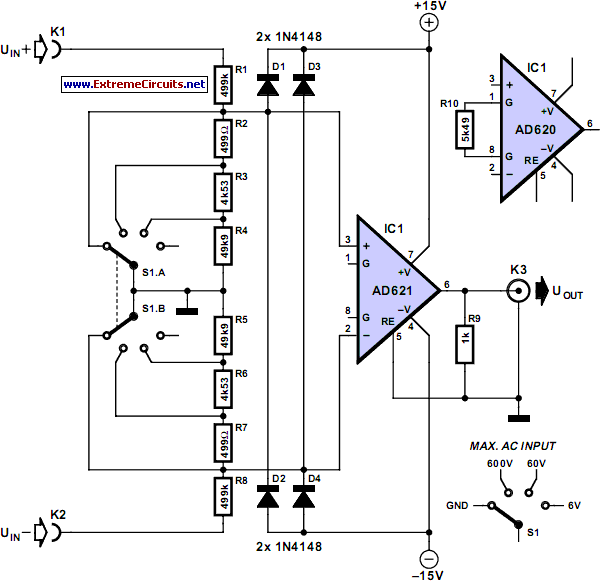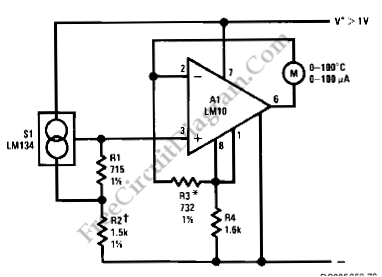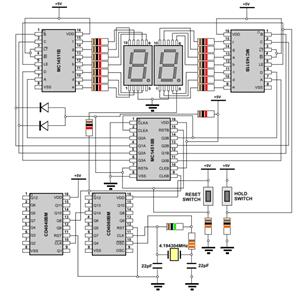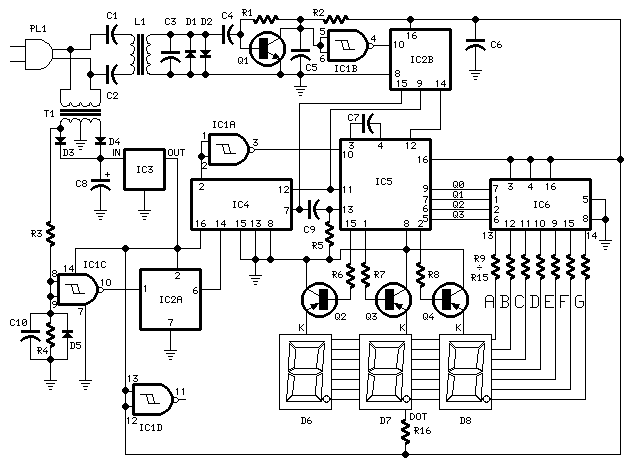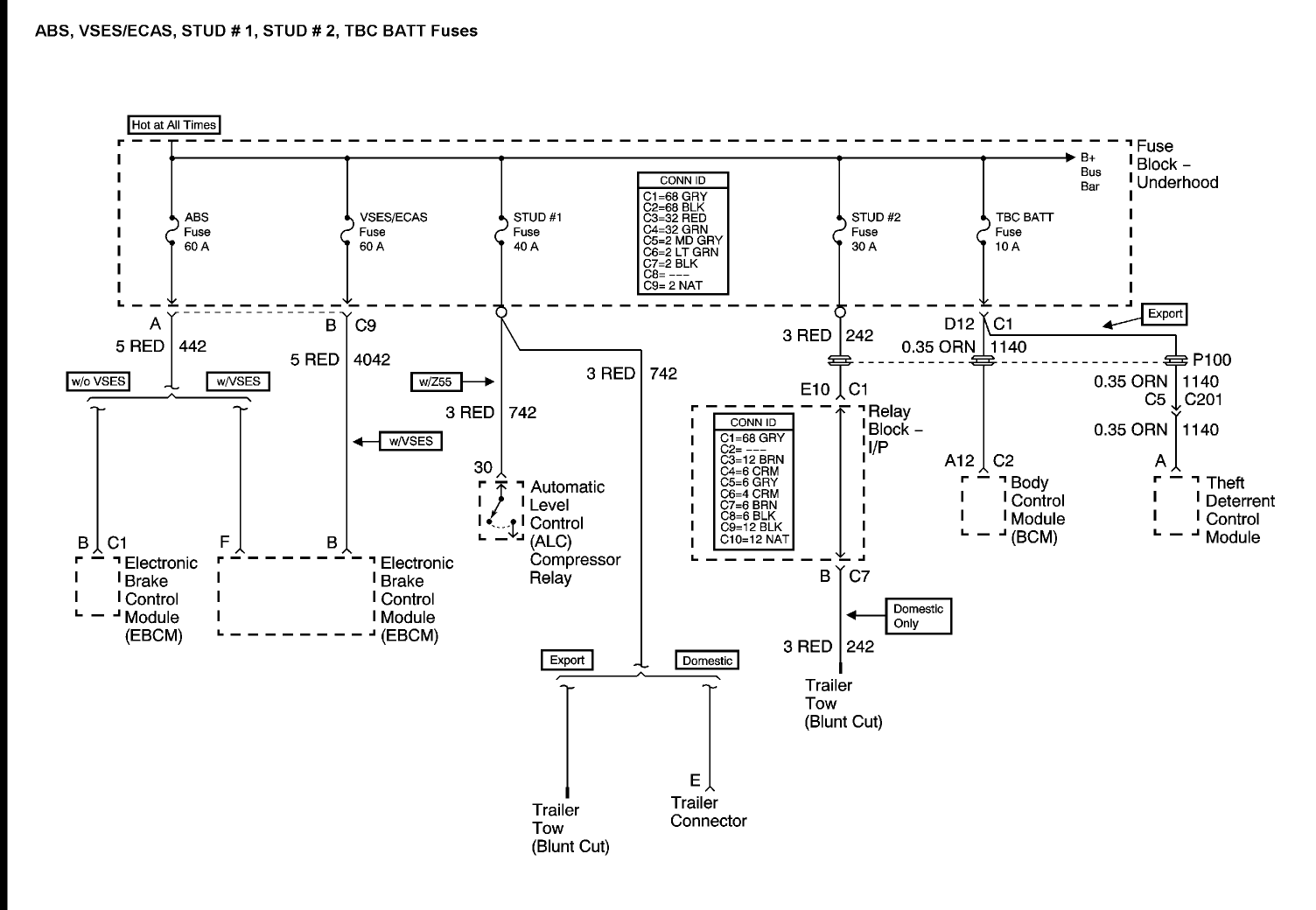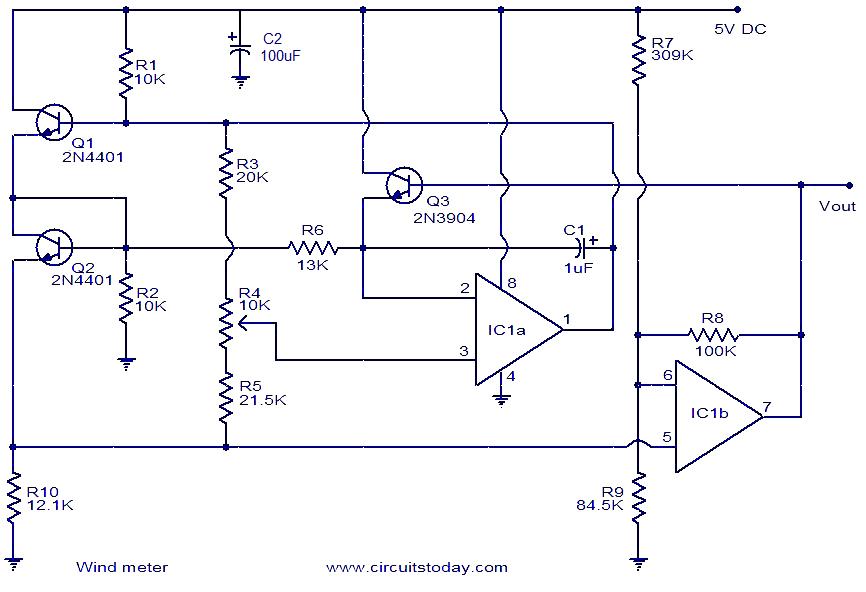
battery meter for pinball machines
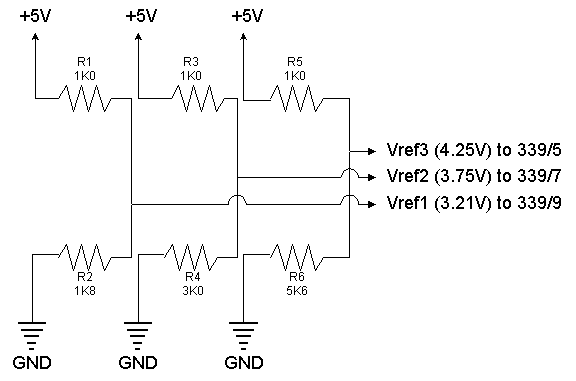
The circuit is designed to fit into a small enclosure that can be placed in a backbox at a location of your choice. It requires only three wires: one for the battery positive voltage, one for the +5 volts from the MPU board or power supply, and a common ground return. The circuit is intended for use with 4.5-volt battery packs (three cells at 1.5 volts each). It provides battery level indication using three LEDs: one green (indicating good), one amber/yellow (indicating mid-level), and one flashing red LED (indicating low battery power at approximately 3.2 volts or less). A voltage drop of 1.3 to 1.5 volts serves as a warning; however, the dropout voltage for CMOS memory standby in WPC games cannot be accurately determined due to the ASIC. Three comparators compare the incoming battery voltage against three reference voltages generated by three potential dividers. These comparators directly drive the LEDs by sinking current to ground. Upon power-up, the green LED will illuminate, indicating good battery power. As the battery voltage decreases, the amber LED lights up, followed by the flashing red LED, with the previous LEDs remaining illuminated until all are lit. The circuit is designed to minimize component count for easier assembly. For modifications that allow LEDs to extinguish sequentially, a 74HC03 quad NAND gate with open-drain outputs can be integrated to sink the LED current, with inputs switched by the next comparator in sequence. It is crucial to note that if the battery pack voltage is 4.21 volts or greater when new, all LEDs will remain off. New batteries may not always deliver their specified voltage, and a slight voltage drop is typical. The potential dividers R1+R2, R3+R4, and R5+R6 provide the reference voltages. To modify the circuit for different reference outputs, the potential divider voltage can be calculated using a specific formula. The circuit should fit on a 2"x2" board. Begin by constructing the potential dividers/voltage references, supplying them with +5 volts and ground (including capacitors C1 and C2), and measuring the output to ensure it aligns with the expected figures. Next, add a 14-pin socket to the board and route the reference voltages to the appropriate pins according to the schematic, followed by connecting +5 volts and ground, and verifying the voltages at the socket. Then, incorporate the 330-ohm LED current limiting resistors R10-R12 and the LEDs onto the board (or use small flyleads for mounting on the box cover). Finally, add the LM or CA339 quad comparator and power up the circuit. The green LED should illuminate, except when the battery voltage exceeds 4.21 volts. Adjust the 10k potentiometer to ensure the LEDs light sequentially: green, amber, and then flashing red. If the circuit does not function correctly, power down and check all connections. Once operational, remove the Vbat simulation and attach three flyleads for connection to the MPU board of the game, designating a red wire for +5 volts, a black wire for ground, and another wire of choice for the Vbat line. Assemble all components into a small box and mount it onto the backbox wall. It is recommended to drill holes in the cover for the LEDs to protrude or to connect them to the board with small flyleads and secure them to the box cover. Solder the flyleads to the MPU board with the power off, allowing the board to sit for two minutes before soldering to ensure onboard capacitors do not retain a charge. Exercise caution and avoid tapping the +5 volts from a chip leg; instead, locate a free pad on the board. Wire the battery power from the pack to the board and return to a suitable ground point. Maintain a tidy assembly, using tie-wraps to organize the flyleads and ensure a professional appearance.
The circuit described is a compact battery level indicator specifically designed for use with 4.5-volt battery packs. It efficiently utilizes three LEDs to provide visual feedback on the battery status, leveraging comparators for precise voltage monitoring. The design emphasizes simplicity and ease of assembly, making it suitable for users with varying levels of electronics experience. The use of potential dividers for reference voltage generation allows for flexibility in adapting the circuit to different battery configurations. The inclusion of a quad comparator ensures accurate voltage comparisons, while the option to modify the LED indication sequence adds versatility to the design. This circuit is ideal for applications where battery monitoring is critical, such as in gaming machines, ensuring users are promptly alerted to changes in battery status.The circuit is designed to be fitted into a small box and then fitted into your backbox (the exact choice of position is yours). Only 3 wires are required one for the battery +v, one for the supply +5 volts from the MPU board or power supply and a common return to ground.
The circuit is designed for 4. 5 volt battery packs (3 cell x 1. 5 volts). The circuit gives level indication using 3 LED`s one green (good), one amber/yellow (mid) and one flashing red LED indicating low battery power 3. 2v or less approx. I think a 1. 3-1. 5 volt drop should be enough warning I can`t guage the drop-out voltage for CMOS memory standby in WPC games because of the ASIC, so, I`ve gone for what you see here.
3 comparators compare the incomming battery voltage against 3 reference voltages provided by 3 potential dividers (see schematic), the 3 comparators directly drive the LED`s by sinking current to ground (internal). On power-up, the Green LED will always be on indicating good battery power. As the battery voltage drops, the amber LED will light, followed by the red flashing LED, the previous LED`s remain on until all the LED`s are lit.
I designed the circuit in this manner to cut down the component count and make the building easier. If you wish to modify the circuit so that LED`s will extinguish one after the other I suggest you use a 74HC03 quad NAND gate with open-drain outputs to sink the LED current, and, who`s input`s is switched by next comparator in sequence thereby turning the previous gate off (I would have given the schematic details here but I don`t have the IC handy to incorporate into the design at the time). IMPORTANT NOTE: If your battery pack provides 4. 21 volts or greater when new then all the leds will remain off. In most cases, new batteries do not always put out their specified voltage - a small voltage drop is usual.
The potential divers R1+R2, R3+R4 and R5+R6 provide the reference voltages. If you wish to modify the circuit to output different references, then the potential divider voltage can be given by the formula: The circuit should fit on a board 2"x 2". Build the potential divders/voltage references first, supply them with +5 volts and ground (don`t forget capacitors C1/2) and measure the output they should be approx the figures given.
Next:- add a 14 pin socket (absolutely vital) to the board and run the reference voltages to the correct pins according to the schematic, then +5 volts and ground now measure the voltages at the socket to ensure they`re present. Next:- add the 330 ohm LED current limiting resistors R10-R12 followed by the LED`s to the board (or mount them on small flyleads for fitting to the box cover).
Last but not least - add the LM or CA339 quad comparator and power up. You should have the green LED on (exception, battery >4. 21v) now rotate the 10k pot and the LED`s should light in sequence green, amber then flashing red. If they do not then power down and CHECK YOUR CONNECTIONS. If the circuit works correctly then removed the Vbat sim. and add the 3 flyleads to allow connection to the MPU board of your game. I suggest you use a red wire for +5 volts, a black wire for ground and another wire of you choice for the Vbat line. Add all the bits into a little box and mount the box onto the backbox wall. I suggest that you actually drill holes in the cover for the LED`s to protrude through, or, connect them to the board with small flyleads and glue them into the box cover.
Solder the flyleads to the MPU board with the POWER OFF. Allow the board 2 minutes before soldering in the leads as the onboard capacitors may still hold a charge. USE COMMON SENSE! don`t tap the +5 volts for the circuit from a chip leg find a free pad on the board that you can tap from.
Wire the battery power from the pack were it enters the board and return to a suitable earth point. KEEP IT NEAT! Take pride in you work make the flyleads tidy use tye-wraps and lay t 🔗 External reference
The circuit described is a compact battery level indicator specifically designed for use with 4.5-volt battery packs. It efficiently utilizes three LEDs to provide visual feedback on the battery status, leveraging comparators for precise voltage monitoring. The design emphasizes simplicity and ease of assembly, making it suitable for users with varying levels of electronics experience. The use of potential dividers for reference voltage generation allows for flexibility in adapting the circuit to different battery configurations. The inclusion of a quad comparator ensures accurate voltage comparisons, while the option to modify the LED indication sequence adds versatility to the design. This circuit is ideal for applications where battery monitoring is critical, such as in gaming machines, ensuring users are promptly alerted to changes in battery status.The circuit is designed to be fitted into a small box and then fitted into your backbox (the exact choice of position is yours). Only 3 wires are required one for the battery +v, one for the supply +5 volts from the MPU board or power supply and a common return to ground.
The circuit is designed for 4. 5 volt battery packs (3 cell x 1. 5 volts). The circuit gives level indication using 3 LED`s one green (good), one amber/yellow (mid) and one flashing red LED indicating low battery power 3. 2v or less approx. I think a 1. 3-1. 5 volt drop should be enough warning I can`t guage the drop-out voltage for CMOS memory standby in WPC games because of the ASIC, so, I`ve gone for what you see here.
3 comparators compare the incomming battery voltage against 3 reference voltages provided by 3 potential dividers (see schematic), the 3 comparators directly drive the LED`s by sinking current to ground (internal). On power-up, the Green LED will always be on indicating good battery power. As the battery voltage drops, the amber LED will light, followed by the red flashing LED, the previous LED`s remain on until all the LED`s are lit.
I designed the circuit in this manner to cut down the component count and make the building easier. If you wish to modify the circuit so that LED`s will extinguish one after the other I suggest you use a 74HC03 quad NAND gate with open-drain outputs to sink the LED current, and, who`s input`s is switched by next comparator in sequence thereby turning the previous gate off (I would have given the schematic details here but I don`t have the IC handy to incorporate into the design at the time). IMPORTANT NOTE: If your battery pack provides 4. 21 volts or greater when new then all the leds will remain off. In most cases, new batteries do not always put out their specified voltage - a small voltage drop is usual.
The potential divers R1+R2, R3+R4 and R5+R6 provide the reference voltages. If you wish to modify the circuit to output different references, then the potential divider voltage can be given by the formula: The circuit should fit on a board 2"x 2". Build the potential divders/voltage references first, supply them with +5 volts and ground (don`t forget capacitors C1/2) and measure the output they should be approx the figures given.
Next:- add a 14 pin socket (absolutely vital) to the board and run the reference voltages to the correct pins according to the schematic, then +5 volts and ground now measure the voltages at the socket to ensure they`re present. Next:- add the 330 ohm LED current limiting resistors R10-R12 followed by the LED`s to the board (or mount them on small flyleads for fitting to the box cover).
Last but not least - add the LM or CA339 quad comparator and power up. You should have the green LED on (exception, battery >4. 21v) now rotate the 10k pot and the LED`s should light in sequence green, amber then flashing red. If they do not then power down and CHECK YOUR CONNECTIONS. If the circuit works correctly then removed the Vbat sim. and add the 3 flyleads to allow connection to the MPU board of your game. I suggest you use a red wire for +5 volts, a black wire for ground and another wire of you choice for the Vbat line. Add all the bits into a little box and mount the box onto the backbox wall. I suggest that you actually drill holes in the cover for the LED`s to protrude through, or, connect them to the board with small flyleads and glue them into the box cover.
Solder the flyleads to the MPU board with the POWER OFF. Allow the board 2 minutes before soldering in the leads as the onboard capacitors may still hold a charge. USE COMMON SENSE! don`t tap the +5 volts for the circuit from a chip leg find a free pad on the board that you can tap from.
Wire the battery power from the pack were it enters the board and return to a suitable earth point. KEEP IT NEAT! Take pride in you work make the flyleads tidy use tye-wraps and lay t 🔗 External reference
